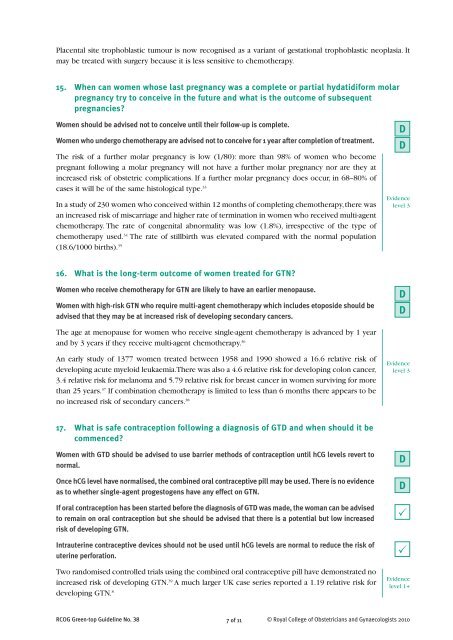The Management of Gestational Trophoblastic Disease - Green-top 38
The Management of Gestational Trophoblastic Disease - Green-top 38
The Management of Gestational Trophoblastic Disease - Green-top 38
Create successful ePaper yourself
Turn your PDF publications into a flip-book with our unique Google optimized e-Paper software.
Placental site trophoblastic tumour is now recognised as a variant <strong>of</strong> gestational trophoblastic neoplasia. It<br />
may be treated with surgery because it is less sensitive to chemotherapy.<br />
15. When can women whose last pregnancy was a complete or partial hydatidiform molar<br />
pregnancy try to conceive in the future and what is the outcome <strong>of</strong> subsequent<br />
pregnancies?<br />
Women should be advised not to conceive until their follow-up is complete.<br />
Women who undergo chemotherapy are advised not to conceive for 1 year after completion <strong>of</strong> treatment.<br />
<strong>The</strong> risk <strong>of</strong> a further molar pregnancy is low (1/80): more than 98% <strong>of</strong> women who become<br />
pregnant following a molar pregnancy will not have a further molar pregnancy nor are they at<br />
increased risk <strong>of</strong> obstetric complications. If a further molar pregnancy does occur, in 68–80% <strong>of</strong><br />
cases it will be <strong>of</strong> the same histological type. 33<br />
In a study <strong>of</strong> 230 women who conceived within 12 months <strong>of</strong> completing chemotherapy, there was<br />
an increased risk <strong>of</strong> miscarriage and higher rate <strong>of</strong> termination in women who received multi-agent<br />
chemotherapy. <strong>The</strong> rate <strong>of</strong> congenital abnormality was low (1.8%), irrespective <strong>of</strong> the type <strong>of</strong><br />
chemotherapy used. 34 <strong>The</strong> rate <strong>of</strong> stillbirth was elevated compared with the normal population<br />
(18.6/1000 births). 35<br />
D<br />
D<br />
Evidence<br />
level 3<br />
16. What is the long-term outcome <strong>of</strong> women treated for GTN?<br />
Women who receive chemotherapy for GTN are likely to have an earlier menopause.<br />
Women with high-risk GTN who require multi-agent chemotherapy which includes e<strong>top</strong>oside should be<br />
advised that they may be at increased risk <strong>of</strong> developing secondary cancers.<br />
D<br />
D<br />
<strong>The</strong> age at menopause for women who receive single-agent chemotherapy is advanced by 1 year<br />
and by 3 years if they receive multi-agent chemotherapy. 36<br />
An early study <strong>of</strong> 1377 women treated between 1958 and 1990 showed a 16.6 relative risk <strong>of</strong><br />
developing acute myeloid leukaemia. <strong>The</strong>re was also a 4.6 relative risk for developing colon cancer,<br />
3.4 relative risk for melanoma and 5.79 relative risk for breast cancer in women surviving for more<br />
than 25 years. 37 If combination chemotherapy is limited to less than 6 months there appears to be<br />
no increased risk <strong>of</strong> secondary cancers. <strong>38</strong><br />
Evidence<br />
level 3<br />
17. What is safe contraception following a diagnosis <strong>of</strong> GTD and when should it be<br />
commenced?<br />
Women with GTD should be advised to use barrier methods <strong>of</strong> contraception until hCG levels revert to<br />
normal.<br />
Once hCG level have normalised, the combined oral contraceptive pill may be used. <strong>The</strong>re is no evidence<br />
as to whether single-agent progestogens have any effect on GTN.<br />
If oral contraception has been started before the diagnosis <strong>of</strong> GTD was made, the woman can be advised<br />
to remain on oral contraception but she should be advised that there is a potential but low increased<br />
risk <strong>of</strong> developing GTN.<br />
Intrauterine contraceptive devices should not be used until hCG levels are normal to reduce the risk <strong>of</strong><br />
uterine perforation.<br />
Two randomised controlled trials using the combined oral contraceptive pill have demonstrated no<br />
increased risk <strong>of</strong> developing GTN. 39 A much larger UK case series reported a 1.19 relative risk for<br />
developing GTN. 8<br />
D<br />
D<br />
P<br />
P<br />
Evidence<br />
level 1+<br />
RCOG <strong>Green</strong>-<strong>top</strong> Guideline No. <strong>38</strong> 7 <strong>of</strong> 11 © Royal College <strong>of</strong> Obstetricians and Gynaecologists 2010
















